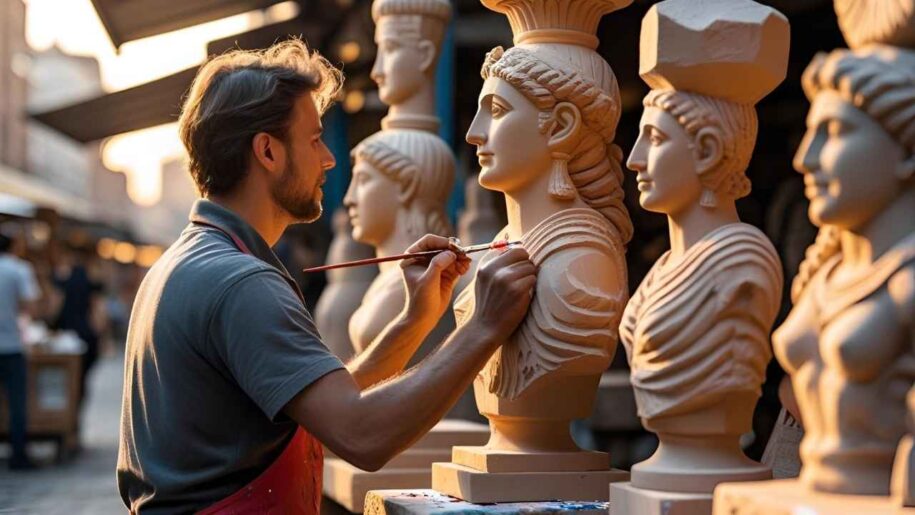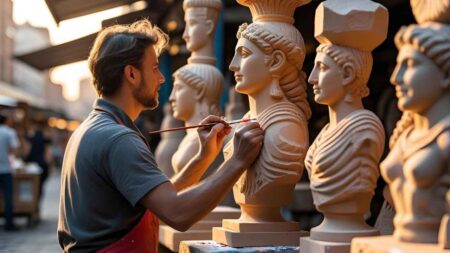Human creativity has spanned millennia, leaving behind masterpieces under the term “ancient artz.” This rich artistic journey—from cave paintings to majestic architecture—reveals the beliefs, traditions, and ingenuity of early civilizations. Join us as we explore its origins, techniques, and enduring legacy.
What Is Ancient Artz?
Defining Artistic Expression from Antiquity
“Ancient artz” encompasses visual and material culture created by societies from the Upper Paleolithic (~40,000 BCE) to the medieval transition around 800 CE. It includes cave paintings, sculpture, pottery, metalwork, reliefs, architecture, and more.
The Origins of Ancient Artz
Prehistoric Imagery: Cave Paintings & Petroglyphs
Earliest examples, like Lascaux (France) and Altamira (Spain), show hunter-gatherers using natural pigments to depict animals and rituals—an early blend of art and spirituality.
Symbolic Sculptures: Venus Figurines & Ritual Objects
Small stone or ivory figures, often depicting fertility or ritual, served sacred roles—tying communities to unseen forces.
Major Civilizations & Their Artistic Legacies
Mesopotamian Art
From ziggurats to cylinder seals and reliefs, societies like the Sumerians and Babylonians used art to represent power, mythology, and law—like the Stele of Hammurabi and the Standard of Ur.
Egyptian Art
Highly symbolic and monumental—pyramids, tomb murals, hieroglyphs, and statues upheld religious order. Colors and perspectives followed strict rules to convey social hierarchy and cosmology.
Greek & Roman Art
Greeks established idealism in sculpture and architecture (Doric, Ionic, Corinthian). Romans combined realism, portraiture, mosaics, and grand structures like the Colosseum and Pantheon.
Asian Art (Chinese, Indian, Japanese)
Asian traditions featured jade/bronzework, calligraphy, serene Buddhism-inspired sculptures, and millennia-old pottery—like China’s Terracotta Army and India’s Ajanta murals.
Mesoamerican & African Art
Olmec, Maya, and Aztec civilizations produced calendric sculptures and murals. African rock art, Nok terracottas, bois masks all conveyed spiritual and cultural narratives.
Themes & Symbols in Ancient Artz
Religion & Ritual
Artworks often had ceremonial or sacred uses—Egyptian gods, Mesopotamian kings, and ancestral veneration symbolized spiritual and cultural ideals .
Power & Politics
Monuments like stele, temples, and coliseums communicated authority, civic pride, and unity.
Nature & Everyday Life
Scenes of hunting, farming, weaving, and mythology reveal daily existence and relationship with nature.
Materials & Techniques of Antiquity
-
Stone & Cave Surfaces: charcoal and ochre pigments
-
Ceramics & Pottery: red/black figure vases, ritual vessels
-
Bronze & Jade: ritual vessels in Asia, Mediterranean metalwork
-
Frescoes & Mosaics: Roman interior decoration
-
Monumental Architecture: precise carving, layered construction
Why Ancient Artz Still Inspires Today
-
Storytelling & Identity: Symbols that shaped collective memory
-
Classic Aesthetic Foundations: Timeless design principles seen in modern art
-
Modern Preservation & Archaeology: Digital restoration keeps culture alive
Preserving Ancient Artz for Future Generations
Conservation and digital archiving are crucial in protecting these treasures from decay, looting, and climate-related threats. Museums worldwide use restoration techniques to maintain cultural heritage.
Frequently Asked Questions (FAQs)
1. What is the oldest ancient art?
Prehistoric cave paintings (e.g., Lascaux, Altamira), dating over 30,000 years old.
2. What materials were used in ancient art?
Natural pigments, stone, bronze, pottery, jade, wood, frescoes, and textiles.
3. What’s the purpose of Venus figurines?
Likely fertility symbols or ritual effigies tied to women’s roles in ancient societies .
4. Why are petroglyphs important?
They document prehistoric rituals, environmental relationships, and early communication .
5. How do we understand ancient art today?
Through archaeology, cultural context, carbon dating, and stylistic comparison.
6. Is ancient art mainly decorative?
No—created for utility, spirituality, history-telling, and social cohesion.
Conclusion
Ancient artz is humanity’s earliest conversation with itself—spanning beauty, belief, power, and place. From cave walls to carved temples, these creations have shaped civilizations and continue to inspire modern artists, scholars, and storytellers. As we preserve and study them, we keep alive the timeless wisdom and creativity of our collective past.
















